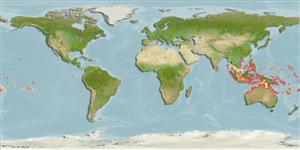>
Ovalentaria/misc (Various families in series Ovalentaria) >
Pomacentridae (Damselfishes) > Pomacentrinae
Etymology: Chrysiptera: Greek, chrysos = golden + Greek, pteron = fin, wing (Ref. 45335); rollandi: Named for Mr. Jean Rolland (R.Bajol, pers.comm. 06/16).
Eponymy: Jean Rolland (1933–2018) was a highly skilled welder by trade. [...] (Ref. 128868), visit book page.
More on author: Whitley.
Environment: milieu / climate zone / rango de profundidad / distribution range
Ecología
marino asociado a arrecife; no migratorio; rango de profundidad 2 - 35 m (Ref. 7247). Tropical; 20°N - 23°S
Eastern Indian Ocean and Western Pacific: Andaman Sea to the Loyalty Islands, north to the Philippines, south to the Great Barrier Reef and New Caledonia. Recently recorded from Tonga (Ref. 53797).
Tamaño / Peso / Age
Madurez: Lm ? range ? - ? cm
Max length : 7.5 cm TL macho / no sexado; (Ref. 48636)
Short description
Claves de identificación | Morfología | Morfometría
Espinas dorsales (total) : 13; Radios blandos dorsales (total) : 10 - 11; Espinas anales: 2; Radios blandos anales: 12 - 13.
Body shape (shape guide): fusiform / normal; Cross section: compressed.
Adults occur singly or in small groups in lagoons, harbors, and outer reef slopes. Found among corals and coral rubble (Ref. 9710). Feed mainly on zooplankton. Oviparous, distinct pairing during breeding (Ref. 205). Eggs are demersal and adhere to the substrate (Ref. 205). Males guard and aerate the eggs (Ref. 205). DNA analysis suggests that this species could be divided to three species at least, i.e. fish from (1) Andaman Sea, (2) Indo-Australian archipelago, and (3) New Caledonia and southern Coral Sea are distinct species. Diurnal species (Ref. 54980; 113699).
Life cycle and mating behavior
Madurez | Reproducción | Puesta | Huevos | Fecundidad | Larva
Oviparous, distinct pairing during breeding (Ref. 205). Eggs are demersal and adhere to the substrate (Ref. 205). Males guard and aerate the eggs (Ref. 205).
Allen, G.R., 1991. Damselfishes of the world. Mergus Publishers, Melle, Germany. 271 p. (Ref. 7247)
IUCN Red List Status (Ref. 130435: Version 2025-1)
Threat to humans
Harmless
Human uses
Pesquerías: sin interés; Acuario: Comercial
Herramientas
Special reports
Download XML
Fuentes de Internet
Estimates based on models
Preferred temperature (Referencia
123201): 25.7 - 29.3, mean 28.6 °C (based on 2147 cells).
Phylogenetic diversity index (Referencia
82804): PD
50 = 0.5000 [Uniqueness, from 0.5 = low to 2.0 = high].
Bayesian length-weight: a=0.01479 (0.00651 - 0.03363), b=3.00 (2.81 - 3.19), in cm total length, based on LWR estimates for this (Sub)family-body shape (Ref.
93245).
Nivel trófico (Referencia
69278): 2.7 ±0.30 se; based on food items.
Resiliencia (Referencia
120179): Alto, población duplicada en un tiempo mínimo inferior a 15 meses (Preliminary K or Fecundity.).
Fishing Vulnerability (Ref.
59153): Low vulnerability (10 of 100).
🛈
Nutrients (Ref.
124155): Calcium = 150 [84, 257] mg/100g; Iron = 0.95 [0.59, 1.49] mg/100g; Protein = 18.5 [17.5, 19.5] %; Omega3 = 0.162 [0.099, 0.256] g/100g; Selenium = 23.6 [13.4, 42.8] μg/100g; VitaminA = 138 [48, 403] μg/100g; Zinc = 2.37 [1.64, 3.27] mg/100g (wet weight);
